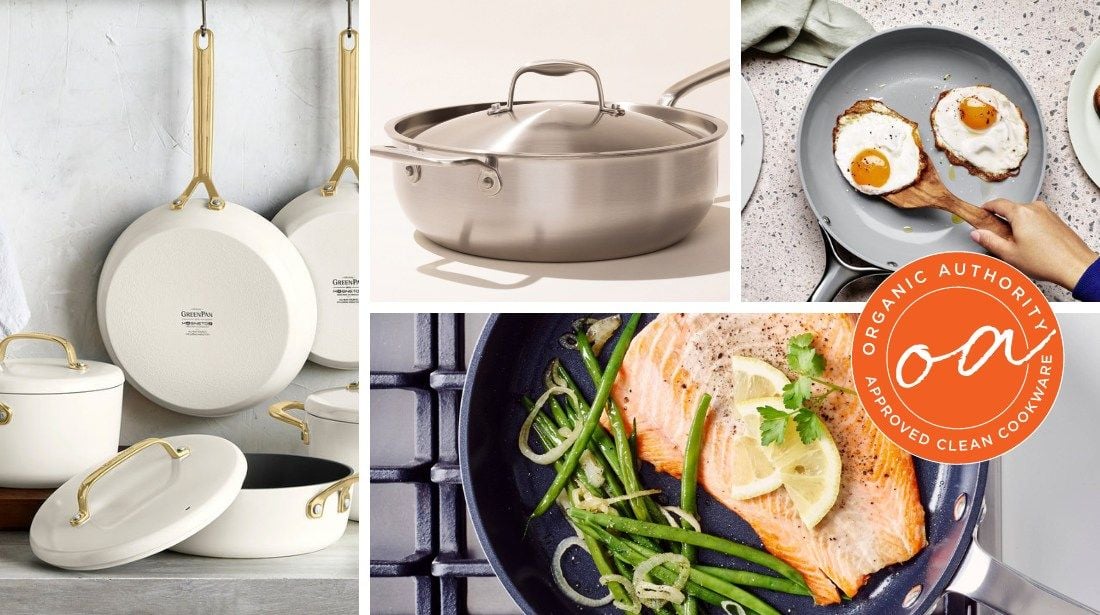*Our test kitchen independently evaluates and reviews products for the OA community. If you click on the links provided, we may receive compensation which helps keep the lights on. Learn more.
Stainless steel and ceramic cookware are arguably the safest and cleanest cookware options on the market. Both options are free of PFAS (also known as ‘forever chemicals’) that can build up in your bloodstream and pollute the environment.
Before we dive into the specific features and the pros and cons of stainless steel vs. ceramic cookware, let’s take a hot minute to understand what forever chemicals are and why it’s so important we opt for clean, non-toxic cookware nowadays. And if you’re looking for a deeper dive on the origins of forever chemicals, check out this article.
What Are Forever Chemicals?
PFAS (per- and poly-fluoroalkyl substances) are a classification of synthetic chemicals more commonly referred to today as forever chemicals.
PFOA, PFOS, PTFE, and GenX chemicals fall under this class of chemicals, along with about 15,000 others. As per the name, these chemicals are nearly impossible to break down — instead, they build up in the environment and in the human body.
Want more top picks for non-toxic cooking? Sign up for the newsletter for more well-researched, clean living guidance and smart wellness advice.
Forever chemicals are used in nonstick materials like Teflon, stain-resistant and waterproof furniture, outdoor gear, and more. In more recent years, we’ve detected PFAS just about everything, from Tampax to popular yoga pants, makeup (hello waterproof mascara!), and our water supply (yikes).
If that list isn’t scary enough for you, we’ve also got a whole article on everyday items that contain forever chemicals. In fact, a recent study even revealed that PFAS have been found in pesticides and pet products.
So while there’s no harm in spending hundreds of dollars on those detox protocols and green juices, it’s worth going back to basics to avoid these common toxins with non-toxic cookware and bakeware first. After all, those forever chemicals are, well, forever.
Make Kitchens Safe Spaces Again
Women are at higher risks of the impacts of forever chemicals as they are major endocrine (hormonal) disruptors and linked to fertility problems.
On top of that, I’m a woman that has always treated the kitchen as my safe space. I see cooking as an expression of love and joy, and the kitchen is the heart of my home for my family.
But to truly feel safe in our own kitchens, it’s worth examining what toxins we might be bringing into them via our cookware. While we may not be able to control all the various environmental factors that affect our health, we can control what we put in our bodies through our go-to cookware.
The Difference Between Ceramic Cookware Vs. Stainless Steel
While both stainless steel and ceramic cookware are great non-toxic cookware options free of forever chemicals, they serve different purposes in the kitchen.
We will cover the pros and cons of each below with some examples, then dive into more specific considerations to help you make the most informed purchasing decision.
The Two Types of Ceramic Cookware
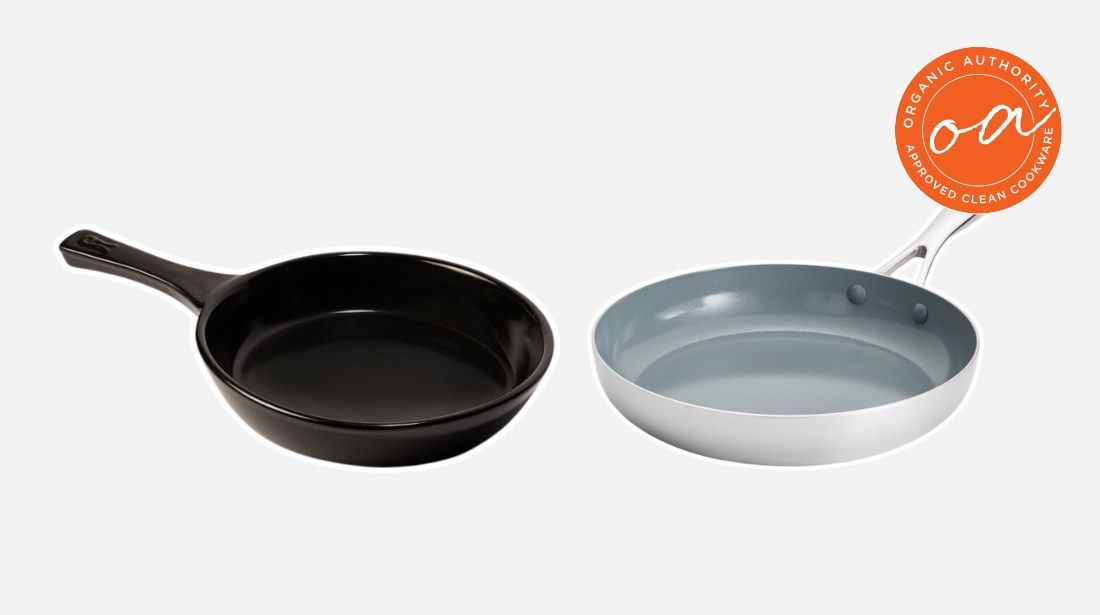
If you’re already committed to buying ceramic cookware, our chef-tested list covers our favorite ceramic cookware options of 2024.
But if you’re still debating which type of cookware is best for you, it’s important to understand your options. There are two types of ceramic cookware —- pure ceramic and ceramic-coated nonstick. When choosing which to buy, here are the differences you should consider.
Pure Ceramic Cookware
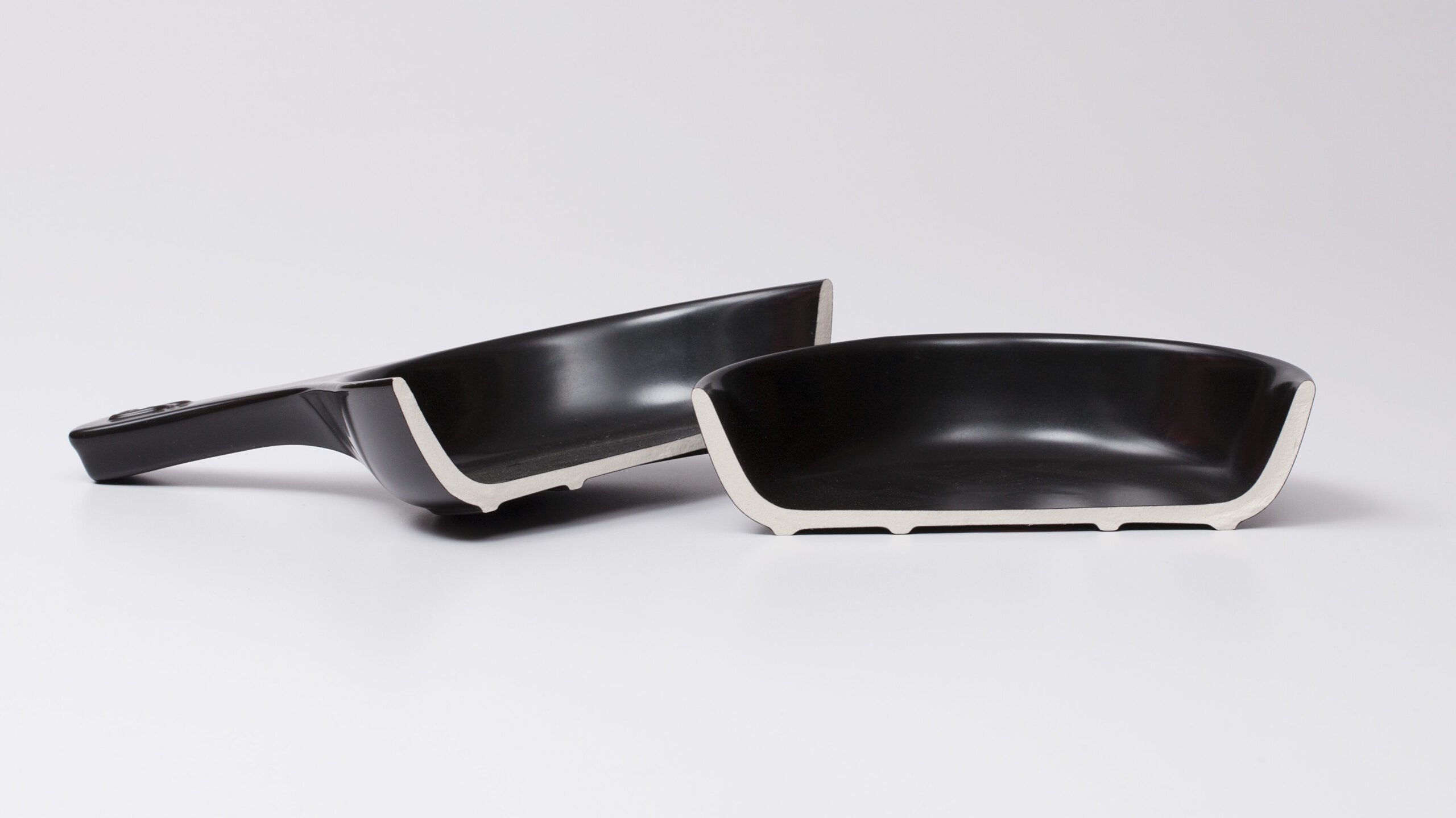
Pure ceramic cookware is exactly what it sounds like. It’s made from clay, water, and natural oxides. Nothing more, nothing less.
Xtrema Pure Cookware is a great example of a modern line of products that are 100% pure ceramic, with no metal core and no silicone or PFAS coating. If you already know pure ceramics are for you, we’d recommend Xtrema Cookware — skip to our detailed review here. But if you’re not sure, let’s go through some of the pros and cons of pure ceramic cookware below.
Pros of Pure Ceramic
Naturally Nonstick
Pure ceramic cookware is the most natural cookware on the market. When used properly, it develops a natural nonstick surface that offers an easy cleanup even with delicate foods like eggs and fish. Because it doesn’t rely on a coating for its nonstick ability, you never have to worry about toxins flaking into your food. You do, however, need to use your favorite oil or butter to achieve a nonstick surface.
Aesthetic Benefits
Pure ceramic also has the bonus of being aesthetically pleasing — some people prefer it purely because of its sturdy, rustic style. Xtrema Cookware offers an all-black look for a modern twist on tradition.
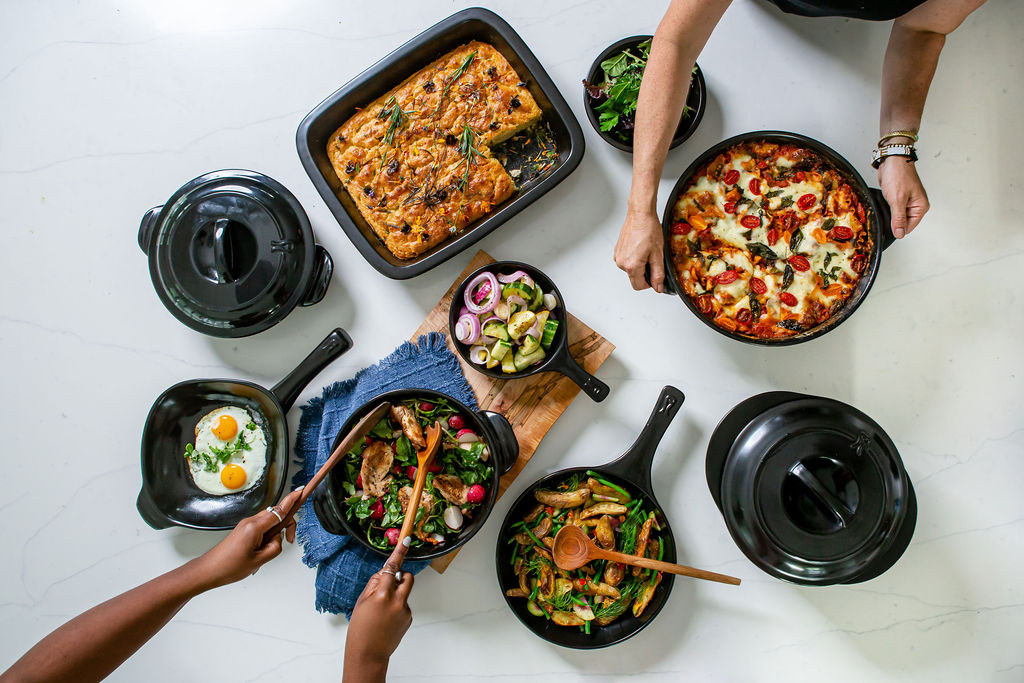
A Worthwhile Investment
Pure ceramic comes in a range of prices, but it’s worth the investment — it has the potential to last a lifetime. While it may not be as durable as stainless steel, careful handling and proper maintenance will help ensure that you can pass this cookware on to your children.
Cons of Pure Ceramic
Prone to Cracks
One drawback of pure ceramic cookware is that you have to be careful to avoid thermal shock. Taking your cookware from high to low temperatures in short periods of time may cause your pots and pans to crack.
Overall, pure ceramic is more fragile than stainless steel, and you should avoid cooking with metal utensils. Recommended materials for your cooking utensils include wood, bamboo, or silicone.
Other Specifications
Ideal Cooking Technique
Pure ceramic cookware is known for its heat retention, which means it cooks evenly and is ideal for low and slow cooking. Because ceramic cookware is fired at an extremely high temperature, it can also withstand more heat than ceramic-coated pans (which are simply coated rather than glazed).
Ceramic-Coated Nonstick Cookware
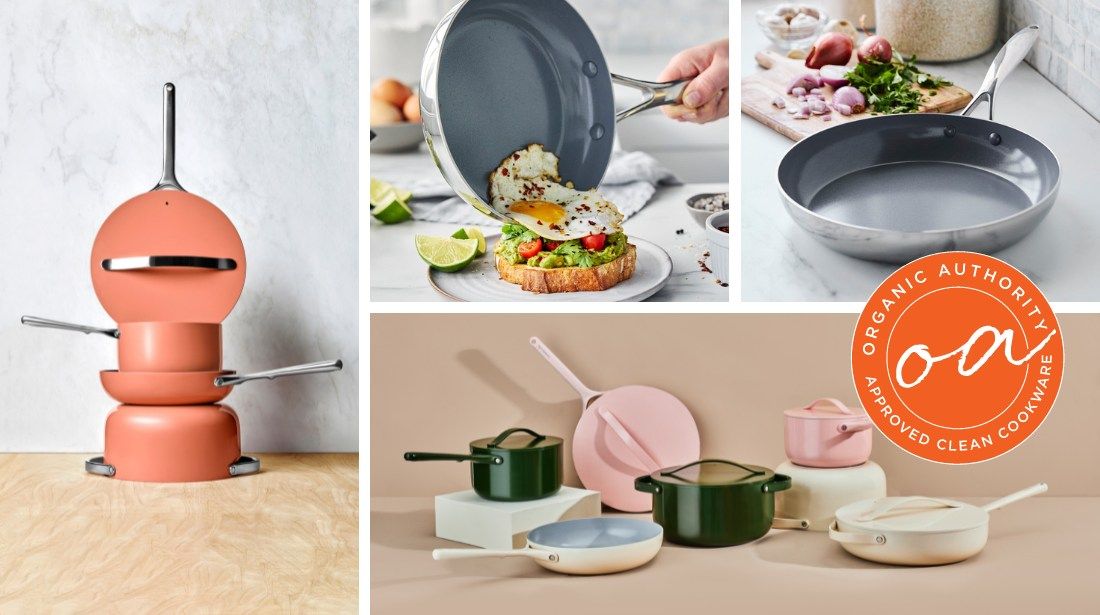
Ceramic-coated nonstick cookware is a more modern invention that was developed as a healthier and sustainable alternative to traditional nonstick cookware made with Teflon (or other toxic PTFE options — read more here on why they aren’t safe).
Ceramic-coated nonstick cookware is usually made with a metal core, consisting of several layers of aluminum for heat conduction and stainless steel for durability. Some view it as a happy medium between pure ceramic and stainless steel cookware, as it offers a natural nonstick surface with a more durable structure beneath it.
If ceramic-coated cookware is your jam, GreenPan is an industry leader that skyrocketed to popularity for offering the first PFAS-free option on the market (read our chef review of GreenPan here).
Another great ceramic-coated nonstick option is Caraway Cookware (you can read our review of Caraway cookware here). These pots and pans are also free of ‘forever chemicals’, and Caraway was recently ranked #1 on our list of the 7 best non-toxic cookware brands in 2024.
Pros of Ceramic-Coated Nonstick Cookware
A Great PFAS-Free Nonstick Option
Ceramic-coated cookware is a great alternative to traditional nonstick cookware that contains forever chemicals. The slick layer in ceramic-coated cookware is derived from natural substances like silicon dioxide or silica, like you’ll see from Caraway, GreenPan, and Alva Cookware. However, not all ceramic-coated cookware brands are created equal — some brands may not be PFAS-free, so be sure to do your research.
Caraway, Alva, and GreenPan all use a slick, inorganic sand-based sol-gel coating to make their cookware nonstick, although GreenPan uses its own proprietary version called Thermolon. All three brands are 100% PFAS-free.
When used properly over low to medium-low heat, ceramic-coated nonstick cookware is super easy to clean, which makes these pots and pans a crowd favorite.
For the Colorful Chef
Ceramic-coated cookware comes in a painter’s palette of colors to fit your kitchen’s design aesthetic. Whether you’re looking for a vibrant pop of color or more muted tones to suit a natural home aesthetic, Caraway and GreenPan both offer a broad color selection.
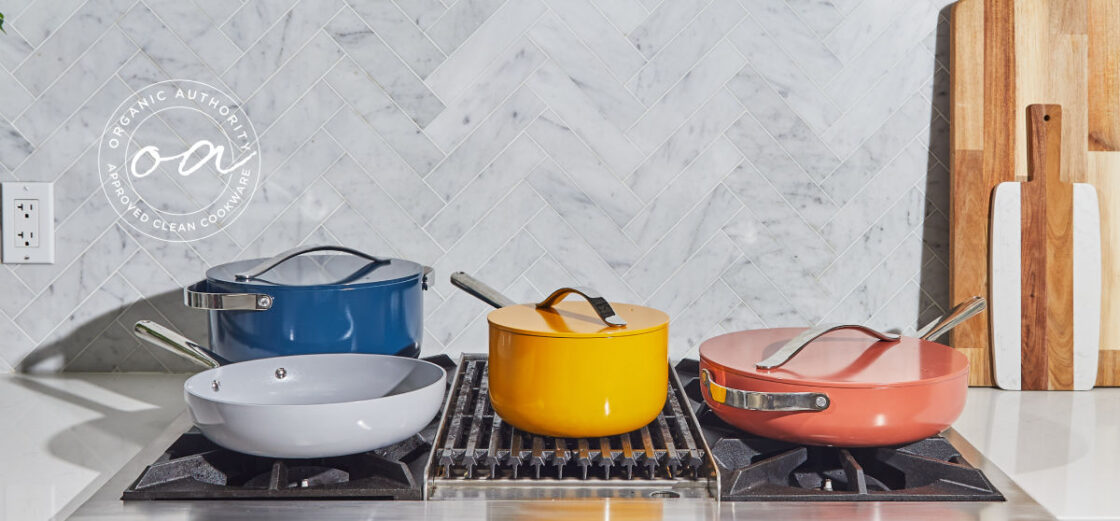
Cons of Ceramic-Coated Nonstick Cookware
Limited to Medium, Medium-Low Heat
Unlike stainless steel, carbon steel, or cast iron, ceramic-coated cookware typically doesn’t handle high heat well. Because high heat can deteriorate the coating, ceramic-coated cookware is best for cooking with medium to medium-low heat.
Most ceramic-coated cookware also requires you to use wood, silicone, or bamboo cooking tools. Metal utensils will scratch it and quickly deteriorate its nonstick coating. Although GreenPan’s cookware sets, depending on which line you get, are resistant to metal utensils, it’s not perfect though. I still recommend wood, silicone or bamboo (you can read more about our top picks for cookware sets by GreenPan here).
A Shorter Lifespan
Unlike more durable options like stainless steel, carbon steel, or cast iron, ceramic-coated cookware doesn’t last a lifetime.
Because its nonstick properties still come from a coating, it’s also more prone to discoloration and deterioration over time. Improper care — like cooking over high heat, running these pots and pans through a hot dishwasher, and using metal utensils — can further accelerate the loss of its nonstick surface.
Other Specifications
Wash By Hand
Most ceramic-coated cookware is not dishwasher safe, as the high heat of the dishwasher tends to quickly degrade the nonstick surface.
There are exceptions — for example, many of GreenPan’s cookware lines are dishwasher-safe. However, we still recommend skipping the dishwasher to get the longest life out of your cookware. Even without the ease of a dishwasher, the slick surface of ceramic-coated options makes them a breeze to wash by hand.
Oven Safety
Depending on the brand, ceramic-coated cookware may or may not be oven-safe up to a certain temperature. For example, many of GreenPan’s collections are oven-safe up to 600 degrees Fahrenheit, while Caraway pans are oven-safe up to 550 degrees Fahrenheit. To protect your cookware, always be sure to follow your manufacturer’s guidelines.
Stainless Steel
While ceramic options are a great choice for avoiding forever chemicals, some people prefer stainless steel. There are plenty of reasons to love stainless steel — it’s a timeless workhorse of professional kitchens and home kitchens alike.
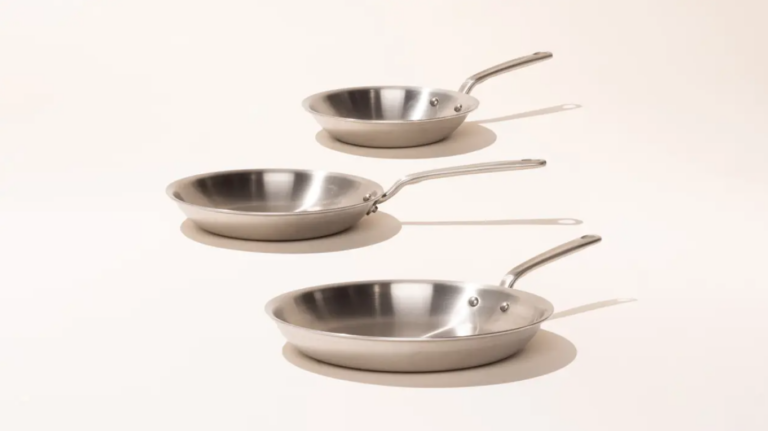
Stainless steel cookware is made from a blend of metals that includes iron, chromium, and, occasionally, nickel. At its purest, stainless steel cookware won’t use any PFAS, silicone, or sol-gel to create a nonstick surfacer. However, there are some cookware brands that offer a nonstick stainless steel option that comes with a PTFE coating, so be sure to stick with the brands we recommend (or do your own research)!
If you’re considering purchasing a stainless steel collection but want to understand more about your options, we also have a detailed guide comparing Stainless Steel Vs. Carbon Steel Vs. Cast Iron.
Stainless Clad Cookware
In your research on stainless steel vs. ceramic cookware, you may also come across the term ‘stainless clad cookware,’ which is when aluminum or copper is sandwiched between layers of stainless steel. This production method makes the cookware more heat-conductive and enables a fast, even cook.
Stainless clad cookware comes in tri-ply or five-ply, which refers to the number of layers of metal it is bonded with. Our in-house expert and Organic Authority Founder, Laura Klein, is a big fan of Demeyere and Made In cookware for stainless clad options.
Pros of Stainless Steel
Durable and Low-Maintenance
Stainless steel is super sturdy and offers a non-reactive surface that won’t react with acidic ingredients, which means no metallic taste. It will last a lifetime and you don’t need to worry about scratching or stripping the metals, regardless of what type of utensils you’re using (and yes, that includes metal!). Many options on the market are also dishwasher-safe, making this a great low-maintenance option (but we still recommend hand washing whenever possible to maximize longevity).
Best Cooking Technique and Versatility
Stainless steel is well-known for being one of the best options for high-heat cooking. You can effortlessly sear veg, steak, and more. Its versatility also means less stress and clean-up for you — it can go from the stovetop to the oven with ease. It can even be used on the grill, and it’s a solid option if you’re looking for cookware to bring along when you go camping.
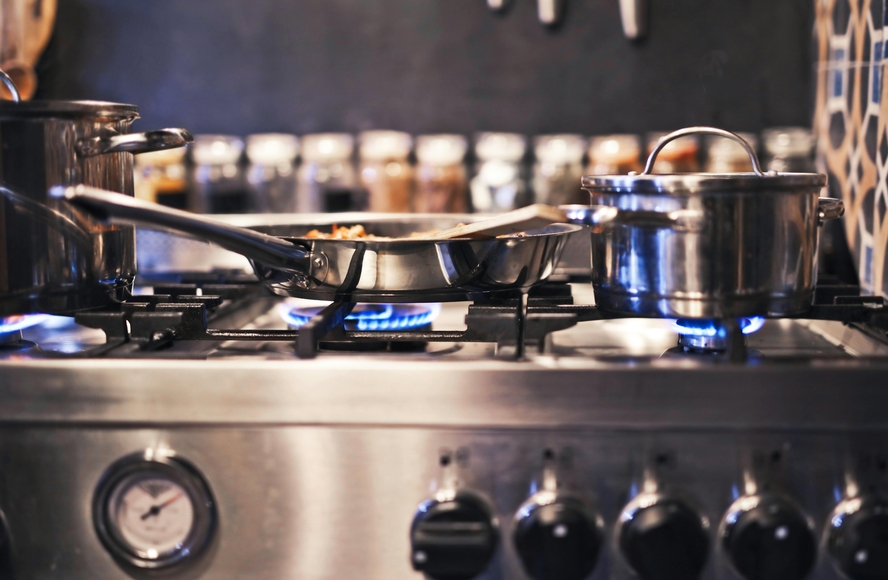
Overall, it’s a great choice for the all-rounder cook looking for a more one-stop shop, including searing, sautéing, frying, boiling, and baking.
Cons of Stainless Steel
Not Naturally Nonstick
Because stainless steel doesn’t have a nonstick surface, it requires more fat for cooking and must be preheated correctly. This also means it tends to be harder to clean than pure ceramic or ceramic-coated nonstick cookware. If you rush the process and don’t give your pan and your oil enough time to heat up before you start cooking, your food may end up a sticky mess, leaving you with a rough cleanup job (here’s more guidance on the right way to cook with oils so you don’t create a mess or scorch the oil).
A Steeper Price Point
Depending on the brand, stainless steel may have a higher price point compared to ceramic-coated cookware, especially for high-quality sets. However, high-quality stainless steel will last you a lifetime. Direct-to-consumer brands like Made-In tend to be more affordable in comparison, but they still might not be the best option for chefs with a tight budget.
Pure Ceramic, Ceramic-Coated, or Stainless Steel: Which Is Best?
The question of stainless steel vs. ceramic cookware ultimately comes down to your cooking habits, health priorities, and budget.
Stainless steel offers unmatched durability, versatility, and performance, making it ideal for a variety of cooking techniques and long-term use. If you love high heat cooking, you definitely need a pan or two in your kitchen just for that. Do you need a whole set? That’s up to you. Stainless steel is especially well-suited to chefs that need long-lasting equipment that can handle a little wear and tear.
On the other hand, ceramic cookware may be the better choice if you need pots and pans for medium to medium-low cooking and you want the slick clean up. You can choose from pure ceramic without a coating or ceramic-coated cookware with a nonstick surface. It all comes down to your personal preference. And you can mix and match your cookware so you can use a different pan to execute different cooking techniques.
Regardless of what you choose in the battle of stainless steel vs. ceramic cookware, investing in high-quality cookware from reputable brands helps ensure a safe and enjoyable cooking experience.
Drop a comment below if you have any specific questions — our in-house expert Laura will share her expert opinion to help make the right choice for you!
P.S. Did you know? Organic Authority has its own nutrition and wellness shop to meet your needs and help you take control of your health. Shop clean supplements for energy, sleep, inner beauty for skin support, protein, workouts, pantry items and more. Shop The Organic Authority Shop now.
Read More on Organic Authority
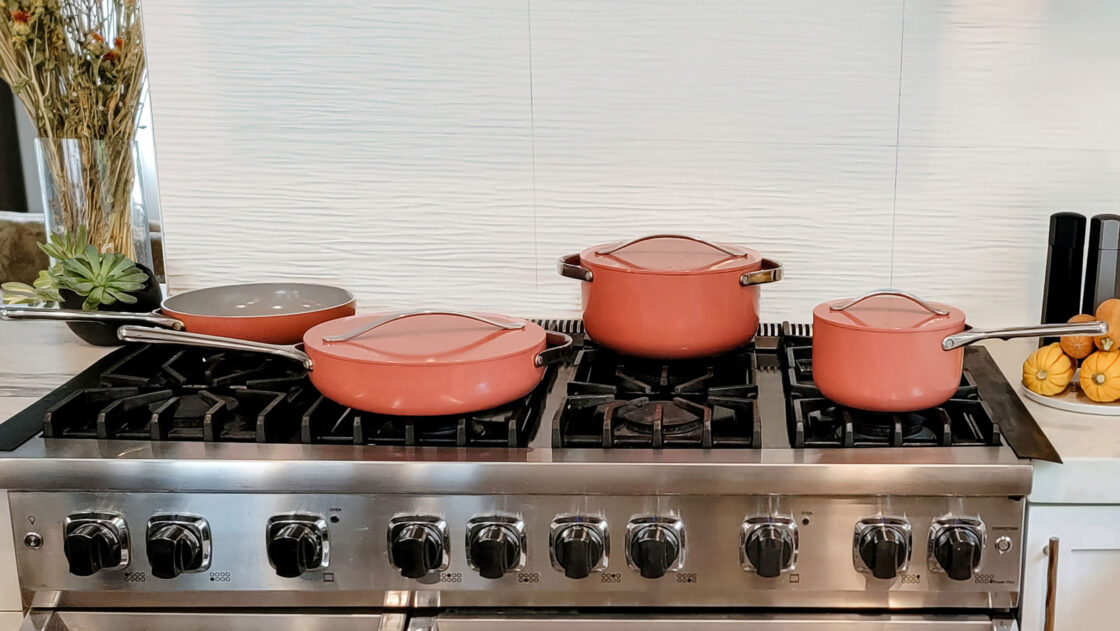
7 Best Non-Toxic Cookware of 2024 [Chef Reviewed, Rated & Ranked]
Xtrema Cookware: A Chef’s Honest Review After 10+ Years of Testing
6 Best Ceramic Cookware Sets 2024: The New Chef Tested Ultimate Guide
Sources:
- https://www.sfenvironment.org/should-i-be-concerned-about-using-non-stick-cookware
- https://www.ehn.org/pfas-tampons-2658510849.html
- https://www.ewg.org/tapwater/contaminant.php?contamcode=E20
- https://www.bcpp.org/resource/pfas-forever-chemicals-pfoa-pfos
Source link

